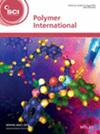求助PDF
{"title":"Tribological and mechanical endowments of polyoxymethylene by liquid-phase exfoliated graphene nanofiller","authors":"Ibrohim Rustamov, Lehong Xiang, Yinshui Xia, Wenfei Peng","doi":"10.1002/pi.6712","DOIUrl":null,"url":null,"abstract":"<p>In this study, a viable route to the development of a high-performance polyoxymethylene (POM)-based nanocomposite is proposed to overcome tribomechanical-related issues in high-precision sliding parts. Prior to melt-blending, graphene nanoplatelet (GNP) filler was processed via a series of liquid-phase exfoliation and surface modification with 3-aminopropyltriethoxysilane. Results indicate that GNP is successfully exfoliated with minimum defect ratio and improves interfacial bonding within the matrix. Uniform dispersion and stable load-transfer capability of POM/GNP with 0.5 wt% loading significantly enhanced flexural, tensile and impact strength by overall 26.4%, in contrast to unfilled POM. Dry friction tests against a steel ball also showed the lowest reduction in friction coefficient and wear rate by 22% and 40.6%, respectively, at the same amount of GNP loading due to the large specific surface coverage and lubricious transfer film chelation onto the steel counterface. Furthermore, dissipated energy accumulation by friction work was calculated in the sliding interfaces based on friction force–displacement hysteresis loop where the POM/GNP 0.5 wt% wear surface consumed <i>ca</i> 21.7% less energy in a dry frictional shearing process compared to neat POM. However, lack or excess loading of processed GNP exhibited insufficient or poor matrix–filler adhesion and led to deterioration of the composite properties due to particle agglomeration which can cause stress concentration and serve as a failure site. The adoption of the proposed methodology would demonstrate excellent material characteristics in thin-walled precision parts where both mechanical and tribological performances are the primary concern. © 2024 Society of Chemical Industry.</p>","PeriodicalId":20404,"journal":{"name":"Polymer International","volume":"74 3","pages":"231-245"},"PeriodicalIF":3.6000,"publicationDate":"2024-10-29","publicationTypes":"Journal Article","fieldsOfStudy":null,"isOpenAccess":false,"openAccessPdf":"","citationCount":"0","resultStr":null,"platform":"Semanticscholar","paperid":null,"PeriodicalName":"Polymer International","FirstCategoryId":"92","ListUrlMain":"https://scijournals.onlinelibrary.wiley.com/doi/10.1002/pi.6712","RegionNum":4,"RegionCategory":"化学","ArticlePicture":[],"TitleCN":null,"AbstractTextCN":null,"PMCID":null,"EPubDate":"","PubModel":"","JCR":"Q2","JCRName":"POLYMER SCIENCE","Score":null,"Total":0}
引用次数: 0
引用
批量引用
Abstract
In this study, a viable route to the development of a high-performance polyoxymethylene (POM)-based nanocomposite is proposed to overcome tribomechanical-related issues in high-precision sliding parts. Prior to melt-blending, graphene nanoplatelet (GNP) filler was processed via a series of liquid-phase exfoliation and surface modification with 3-aminopropyltriethoxysilane. Results indicate that GNP is successfully exfoliated with minimum defect ratio and improves interfacial bonding within the matrix. Uniform dispersion and stable load-transfer capability of POM/GNP with 0.5 wt% loading significantly enhanced flexural, tensile and impact strength by overall 26.4%, in contrast to unfilled POM. Dry friction tests against a steel ball also showed the lowest reduction in friction coefficient and wear rate by 22% and 40.6%, respectively, at the same amount of GNP loading due to the large specific surface coverage and lubricious transfer film chelation onto the steel counterface. Furthermore, dissipated energy accumulation by friction work was calculated in the sliding interfaces based on friction force–displacement hysteresis loop where the POM/GNP 0.5 wt% wear surface consumed ca 21.7% less energy in a dry frictional shearing process compared to neat POM. However, lack or excess loading of processed GNP exhibited insufficient or poor matrix–filler adhesion and led to deterioration of the composite properties due to particle agglomeration which can cause stress concentration and serve as a failure site. The adoption of the proposed methodology would demonstrate excellent material characteristics in thin-walled precision parts where both mechanical and tribological performances are the primary concern. © 2024 Society of Chemical Industry.
液相剥离石墨烯纳米填料对聚甲醛的摩擦学和力学禀赋
在这项研究中,提出了一种可行的途径来开发高性能聚甲醛(POM)纳米复合材料,以克服高精度滑动部件的摩擦力学相关问题。在熔融共混之前,通过液相剥离和3-氨基丙基三乙氧基硅烷的表面改性,制备了石墨烯纳米血小板(GNP)填料。结果表明,GNP能够以最小的缺陷率成功剥离,改善了基体内部的界面结合。与未填充的POM相比,负载为0.5 wt%的POM/GNP的均匀分散和稳定的载荷传递能力显著提高了弯曲、拉伸和冲击强度,总体提高了26.4%。对钢球的干摩擦试验也表明,在相同GNP加载量下,由于大的比表面覆盖率和在钢表面上的润滑转移膜螯合作用,摩擦系数和磨损率分别降低了22%和40.6%。此外,基于摩擦力-位移滞回线计算了滑动界面中摩擦功耗散能量积累,其中POM/GNP为0.5 wt%的磨损表面在干摩擦剪切过程中消耗的能量比纯POM少21.7%。然而,加工后的GNP载荷不足或过大,表明基体与填料的粘附性不足或较差,并由于颗粒团聚而导致复合材料性能恶化,从而引起应力集中并成为失效点。采用所提出的方法将展示薄壁精密零件的优异材料特性,其中机械和摩擦学性能是主要关注的问题。©2024化学工业学会。
本文章由计算机程序翻译,如有差异,请以英文原文为准。




 求助内容:
求助内容: 应助结果提醒方式:
应助结果提醒方式:


